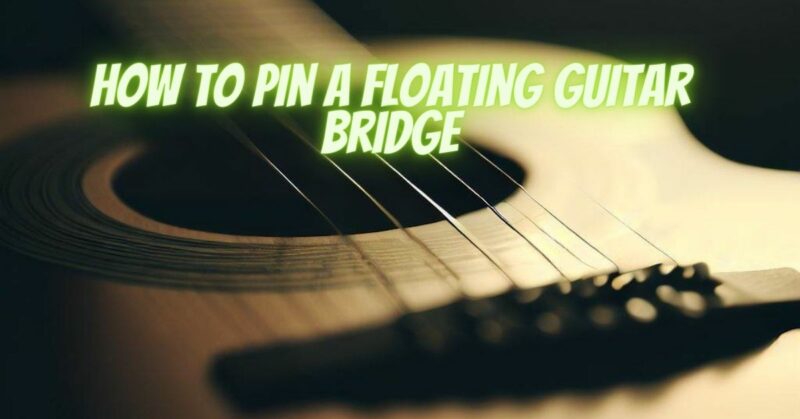Floating bridges are a common feature on many acoustic and archtop guitars, providing players with tonal versatility and expressive potential. However, sometimes, you may want to pin a floating bridge to enhance stability and tone. In this article, we will explore the process of pinning a floating guitar bridge, why you might consider doing so, and the steps involved in achieving a secure and tonally optimized setup.
Understanding Floating Bridges
A floating bridge, also known as a non-fixed or free-floating bridge, is not attached directly to the guitar’s top. Instead, it relies on string tension to hold it in place, allowing for pitch modulation and vibrato effects. While floating bridges offer expressive possibilities, they can be prone to shifting during play, affecting tuning stability and tonal balance.
Why Pin a Floating Bridge?
Pinning a floating bridge is a technique that involves securing the bridge to the guitar’s top, reducing the risk of movement. Here are some reasons why you might consider pinning a floating bridge:
- Enhanced Stability: A pinned bridge provides greater stability during play, reducing the chances of bridge movement that can lead to tuning issues.
- Tonal Improvement: A securely pinned bridge can transfer vibrations more efficiently to the guitar’s top, potentially enhancing tonal resonance and sustain.
- Easier String Changes: Pinning the bridge can simplify the process of changing strings, as the bridge remains in place.
How to Pin a Floating Guitar Bridge:
Tools and Materials You’ll Need:
- Drill and drill bit: Appropriate for creating bridge pin holes.
- Bridge pins: Typically made of bone, plastic, or other materials.
- Measuring tools: To ensure precise placement of bridge pins.
- Ruler or feeler gauges: For accurate measurements.
Step-by-Step Guide to Pinning a Floating Bridge:
Step 1: Measure and Mark Pin Locations
- Measure the distance between the bridge saddle and the 12th fret. This measurement is crucial for precise bridge pin placement.
- Mark the centerline of the bridge by measuring the same distance from the 12th fret towards the soundhole.
- Mark the positions where the bridge pins will be installed, typically six pins for acoustic guitars.
Step 2: Prepare for Drilling
- Select a drill bit that matches the diameter of your bridge pins. Ensure it’s slightly smaller than the pin to create a snug fit.
- Tape the drill bit at the desired depth to avoid drilling too deep into the guitar top.
Step 3: Drill Pin Holes
- Carefully drill holes at the marked positions on the bridge, ensuring you maintain a straight angle.
- Be cautious not to drill too deep; you only need to create holes deep enough to accommodate the bridge pins.
Step 4: Install Bridge Pins
- Gently insert the bridge pins into the freshly drilled holes. Ensure a snug fit without forcing the pins.
- Push the pins down until they are flush with the bridge. The bridge pins should hold the bridge securely.
Step 5: String Up and Tune
- Restring your guitar, making sure the strings are properly seated in the bridge and the tuning pegs.
- Tune your guitar to your desired standard tuning, and check for any necessary adjustments to the saddle height and intonation.
Step 6: Fine-Tuning
- Play your guitar and assess the tonal improvements and enhanced stability provided by the pinned bridge.
Pinning a floating guitar bridge can be a valuable modification for players seeking enhanced stability and potential tonal improvements. By following the steps outlined in this guide, you can securely anchor your bridge to your guitar’s top, reducing the risk of movement and exploring the tonal benefits of this modification. Whether you’re aiming for better stability during performances or seeking to unlock a unique tonal character, pinning your floating bridge can be a rewarding endeavor for any guitarist.

